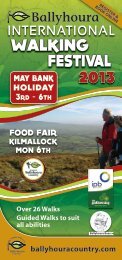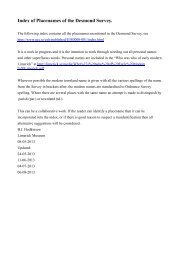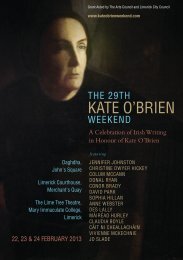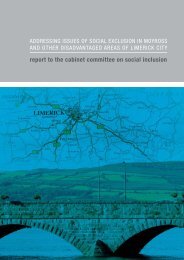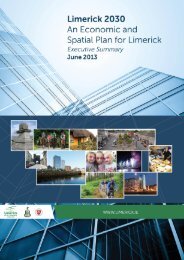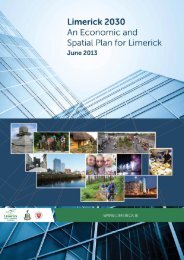An Economic and Spatial Plan for Limerick Appendices
An Economic and Spatial Plan for Limerick Appendices
An Economic and Spatial Plan for Limerick Appendices
Create successful ePaper yourself
Turn your PDF publications into a flip-book with our unique Google optimized e-Paper software.
<strong>Limerick</strong> 2030 <strong>An</strong> <strong>Economic</strong> <strong>and</strong> <strong>Spatial</strong> <strong>Plan</strong> <strong>for</strong> <strong>Limerick</strong><br />
7. Exemplar Studies<br />
In developing an <strong>Economic</strong> <strong>and</strong> <strong>Spatial</strong> <strong>Plan</strong> <strong>for</strong> <strong>Limerick</strong>, inspiration has been taken from good<br />
practice across the world – drawing lessons from individual projects that relate to the<br />
circumstances found in <strong>Limerick</strong>. Many of the projects selected relate to larger cities. In these<br />
instances the key message is not the scale but the idea, the principle or the approach that is<br />
important.<br />
A thematic approach has been adopted addressing the following elements:<br />
Shopping – as there is a need to totally revitalise the shopping offer refit models are there<strong>for</strong>e<br />
most appropriate where modern shopping methods are being implemented. In addition the<br />
independent sector will be essential <strong>for</strong> <strong>Limerick</strong> as will an enhanced outdoor market<br />
environment.<br />
Knowledge – the idea of using higher education in the City Centre to drive economic<br />
change. Also the idea of knowledge/technology led economic change.<br />
City Centre Living – <strong>Limerick</strong> City Centre offers the opportunity <strong>for</strong> different living<br />
environments – Waterfront, Georgian, Medieval <strong>and</strong> 20 th Century. A key area is the<br />
renovation <strong>and</strong> re-use of a Georgian neighbourhood. A comparable example is the Duke<br />
Street/Bold Street area of Liverpool.<br />
Destination/Iconic Buildings – there is much to be learned from the use of culture/tourism<br />
iconic architecture in terms of place making <strong>and</strong> br<strong>and</strong>ing, <strong>for</strong> example Oslo, as well as the<br />
use of culture to drive regeneration.<br />
Events/Festivals – global events are hugely influential in changing image <strong>and</strong> driving tourism<br />
<strong>and</strong> wider investment. A good example is the Manchester International Festival.<br />
Waterfront – there are now many excellent waterfront developments across the world –<br />
though no two are alike. Liverpool has lessons, as has Melbourne <strong>and</strong> Ebro in Portugal.<br />
Sc<strong>and</strong>inavian countries also offer lessons – Copenhagen <strong>and</strong> Oslo are good examples.<br />
Green Cities/Sustainability – this is a growing feature of city design <strong>and</strong> renaissance.<br />
Sc<strong>and</strong>inavian cities offer excellent lessons – Stockholm, Copenhagen. Also Freiburg in<br />
Germany <strong>and</strong> certain north American cities - Chicago.<br />
June 2013 102




